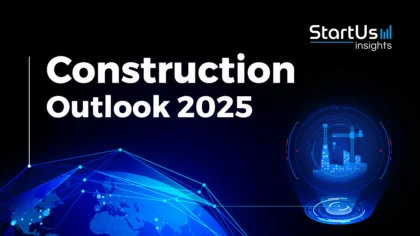Accelerate Productivity in 2025
Reignite Growth Despite the Global Slowdown
Rising global population and rapid urbanization present challenges ranging from climate change-induced infrastructure vulnerabilities to the intricacies of urban sprawl and the need for sustainable construction materials. Civil engineering industry trends such as building information modeling (BIM), advanced materials like self-healing concrete, and integration of artificial intelligence (AI) improve project conceptualization and execution.
What are the new trends in civil engineering?
- Building Information Modeling
- Green Building Materials
- Renewable Energy Integration
- Advanced Robotics
- Geographic Information Systems (GIS)
- Modular Construction & Prefabrication
- Structural Monitoring and Assessment
- 3D Printing
- Advanced Materials
- Disaster Management
Methodology: How We Created the Civil Engineering Trend Report
For our trend reports, we leverage our proprietary StartUs Insights Discovery Platform, covering 5M+ global startups, 20K technologies & trends plus 150M+ patents, news articles, and market reports.
Creating a report involves approximately 40 hours of analysis. We evaluate our own startup data and complement these insights with external research, including industry reports, news articles, and market analyses. This process enables us to identify the most impactful and innovative trends in the civil engineering industry.
For each trend, we select two exemplary startups that meet the following criteria:
- Relevance: Their product, technology, or solution aligns with the trend.
- Founding Year: Established between 2020 and 2025.
- Company Size: A maximum of 200 employees.
- Location: Specific geographic considerations.
This approach ensures our reports provide reliable, actionable insights into the civil engineering innovation ecosystem while highlighting startups driving technological advancements in the industry.
Innovation Map outlines the Top 10 Civil Engineering Trends & 20 Promising Startups
For this in-depth research on the Top Civil Engineering Trends & Startups, we analyzed a sample of 1100+ global startups & scaleups. The Civil Engineering Innovation Map created from this data-driven research helps you improve strategic decision-making by giving you a comprehensive overview of the civil engineering industry trends & startups that impact your company.
Tree Map reveals the Impact of the Trends in Civil Engineering (2025)
Based on the Civil Engineering Innovation Map, the Tree Map below illustrates the impact of the Top Civil Engineering Industry Trends in 2025. Building information modeling enhances design and construction processes with real-time visibility. Green building materials and renewable energy, like low-carbon concrete, solar roofs, and wind-resistant turbines, make infrastructure sustainable.
Modular construction and prefabrication streamline project timelines, and structural monitoring tools like smart sensors ensure safety and longevity. Additionally, 3D printing facilitates rapid prototyping and construction, and advanced materials like self-healing concrete enhance durability.
Global Startup Heat Map covers 1187 Civil Engineering Startups & Scaleups
The Global Startup Heat Map showcases the distribution of 1100+ exemplary startups and scaleups analyzed using the StartUs Insights Discovery Platform. It highlights high startup activity in the UK, followed by the US. From these, 20 promising startups are featured below, selected based on factors like founding year, location, and funding.

Want to Explore Civil Engineering Innovations & Trends?
10 Emerging Trends in Civil Engineering (2025)
1. Building Information Modeling
Infrastructure development projects often showcase inefficient project management, escalating construction costs, and inaccuracies in design coordination. To address these issues, companies are leveraging innovative BIM solutions. Advanced BIM tools streamline project workflows to enable real-time collaboration among stakeholders, reducing design discrepancies.
Further, BIM’s 4D and 5D capabilities offer precise cost estimation and scheduling, curbing unexpected expenses. The integration of augmented reality (AR) with BIM also provides on-site professionals with immersive visualizations to ensure construction accuracy and minimize rework.
Moreover, the BIM market size is projected to grow from USD 8.0 billion in 2024 to USD 14.8 billion by 2029, with a CAGR of 13.1% during this period.

Credit: Markets and Markets
D.TO advances BIM-Integrated Design
US-based startup D.TO develops a BIM-integrated design platform that streamlines architectural processes. It features project data analysis, building assembly design solutions, and smart product searches. Additionally, the platform promotes efficient product integration into specifications and simplifies BIM component integration into designs.
For civil engineering, the platform enhances design accuracy to ensure that structures meet industry standards. Moreover, it allows civil engineers to provide real-time design solutions and mentoring, optimizing the construction process. By integrating BIM directly into drawings, the platform ensures precision and compliance in civil engineering projects.
SeveUp offers a Cloud-based BIM Platform
SeveUp is a French startup that provides cloud-based BIM collaboration and project management solutions for architecture and construction. Its BCF Manager Dashboard and Reports tool tracks model revisions, automates reports, and streamlines issue management. Moreover, the BCF (BIM Collaboration Format) file format ensures effective communication among project stakeholders to capture comments, graphical annotations, and 3D coordinates.
Besides this, BIM Viewer provides a cloud-based platform for visualizing and interacting with BIM models while the QTO Dashboard offers a solution for analyzing BIM models and optimizing construction processes. Further, SeveUp streamlines workflows and ensures the overall quality assurance of construction projects by automating these processes.
2. Green Building Materials
Civil engineers face many concerns such as excessive energy consumption in buildings and the environmental impact of construction waste. Innovations in green building materials are addressing these challenges through self-healing concrete, which reduces the need for frequent repairs and maintenance.
The global green building materials market was valued at USD 26.6 billion in 2024 and is expected to grow at a CAGR of 10.4% from 2025 to 2030.
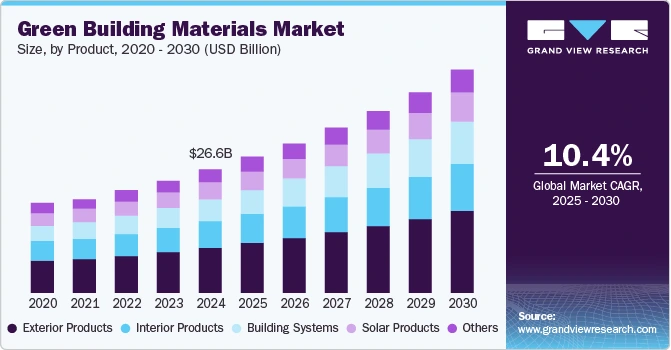
Credit: Grand View Research
Further, bio-based insulation materials, derived from renewable sources, are replacing traditional insulators, offering enhanced energy efficiency. Recycled construction materials, like reclaimed wood and recycled steel, are also minimizing the strain on natural resources.
Moreover, the introduction of photovoltaic (PV) glass in building facades is transforming structures into energy generators, reducing dependency on external power sources.
Respyre manufactures Bioreceptive Concrete
Dutch startup Respyre integrates nature into urban environments by leveraging the benefits of moss. Its bioreceptive concrete serves as a sustainable and circular wall decoration, that also captures CO2. The captured carbon is converted into chalk, offering a CO2-negative building solution.
Moreover, the moss that grows on the concrete enhances air quality, reduces urban stressors, and supports biodiversity. The startup applies the concrete, adds a bio-enhancing gel, and facilitates moss growth over 12 weeks. In this way, the startup promotes sustainable, aesthetic, and eco-friendly urban structures.
Nexii provides a Sustainable Concrete Alternative
Nexii is a Canadian startup that develops Nexiite, a sustainable alternative to traditional concrete. The material features a composition that rapidly cures and achieves high compression strength with significantly lower carbon emissions compared to glass fiber-reinforced concrete.
The startup’s expanded polystyrene II (EPS II)-based insulating core bonds with Nexiite to reduce the need for adhesives and offer efficient thermal protection. The startup’s approach to design for reuse (DfR) emphasizes the continuous reuse of building panels, promoting a circular economy in construction.
3. Renewable Energy Integration
The main challenges in civil engineering include the over-reliance on non-renewable energy sources and the vulnerability of structures to power outages. Therefore, startups are integrating innovations in renewable energy to overcome these issues. For example, engineers are embedding piezoelectric devices in roadways to harness energy from vehicular movement.
Smart grids, powered by solar and wind energy, are replacing conventional grids to ensure a consistent and sustainable power supply. Additionally, kinetic energy storage systems are being integrated into buildings to capture energy for later use, reducing the strain on power grids during peak demand.
Also, the renewable energy integration systems market is projected to grow to USD 212.42 billion by 2029, with a CAGR of 9.5%.

Traverse Technologies specializes in Wind Energy Prospecting
Ghana-based startup Traverse Technologies offers advanced AI-based solutions to assist renewable energy developers in constructing optimal wind farms. Its solution, WindDesk, offers direct IRR and LCOE prospecting at both country and regional levels while also accounting for technical, environmental, social, and commercial factors.
The startup’s prospecting involves the permutation of a large number of energy layouts that encompass wind and site conditions, terrain analysis, turbine selection, road access design, and environmental considerations. Additionally, WindDesk evaluates transport complexities, hydrology, and comprehensive financial modeling to streamline site selection for wind farms, thereby ensuring optimal locations and efficient resource utilization.
Continuum Industries delivers Renewable Energy Infrastructure Analytics
UK-based startup Continuum Industries offers Optioneer, a platform that analyzes key factors on cable routes and grid connections to enhance renewable energy infrastructure programs. It is an AI-powered route engine that automates route analysis for potential scenarios by assessing against various criteria including social, environmental, engineering, and cost.
The startup’s cloud-based approach leverages open-source GIS data and facilitates the configuration of route parameters, evaluation of routes with interactive maps, and more. Moreover, Continuum Industries’ engine enables civil engineers to assess multiple factors impacting onshore and offshore cable development.
4. Advanced Robotics
As the number of civil engineering projects increases, the industry is more impacted by the problems due to labor shortages, construction site safety, and the time-intensive nature of manual tasks. Advanced robots address these challenges by enabling automated operations like drone-powered autonomous site inspections. This approach ensures thorough and rapid assessments while eliminating human exposure to hazardous conditions.
The construction robots market size is estimated at USD 442.49 million in 2025 and is expected to reach USD 909.53 million by 2030, with a CAGR of 15.5% during the forecast period.
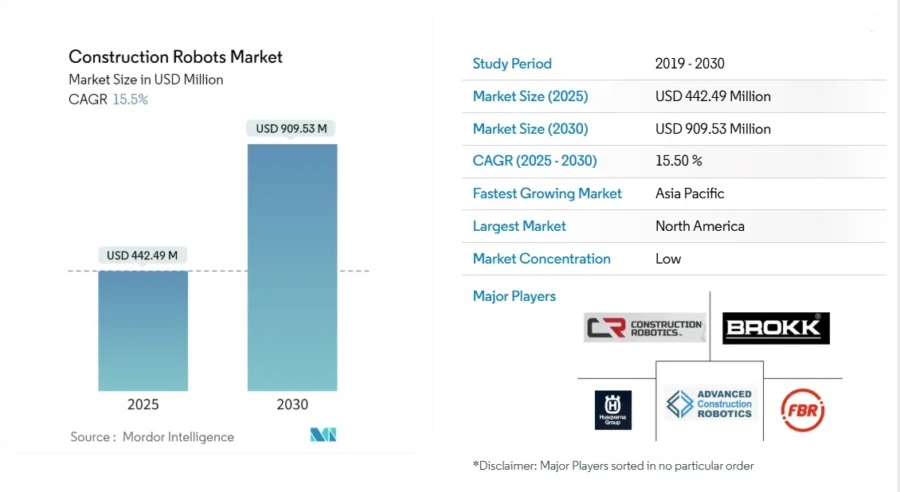
Credit: Mordor Intelligence
Besides, robotic arms equipped with advanced sensors are taking over tasks like bricklaying and concrete pouring, enhancing precision and accelerating project timelines. Wearable robotic exoskeletons in construction sites further augment workers’ strength and reduce physical strain to boost productivity. Through the integration of these robotic innovations, the field of civil engineering is benefitting from a surge in efficiency and safety.
KEWAZO creates a Robotic Material Hoist
KEWAZO is a German startup that automates and enhances construction logistics through robotics and data-driven insights. Its robotic hoist system, LIFTBOT, transports building materials and scaffolding parts efficiently. The system addresses the labor shortage in scaffolding, potentially saving a significant amount in labor costs and improving worker conditions.
Besides, LIFTBOT features a quick installation that takes just a few minutes and operates wirelessly with autonomous control. The startup’s data analytics platform also collects operational data to provide real-time project performance insights. KEWAZO’s solutions streamline construction processes, ensuring safety, efficiency, and cost-effectiveness in material transportation.
PaceRobotics develops a Wall Finishing Robot
Indian startup PaceRobotics creates a wall finishing robot that is designed for plastering, putty, and painting of building interiors and operates at faster speeds than traditional methods. The modular multi-tasking robot integrates real-time data collection, providing insights into execution processes.
The startup’s technology provides a significant increase in productivity, reduction in costs, and eliminates health and safety hazards. PaceRobotic’s robotic solutions enhance efficiency and ensure consistent quality as well as address skilled labor shortages.
5. Geographic Information Systems
Urban and rural development projects are prone to inaccurate site analysis, difficulties in land-use planning, and complexities in infrastructure placement. That is why civil engineering companies are assisting engineers with geographic information systems. They utilize GIS for high-resolution terrain mapping to ensure accurate site evaluations and minimize risks associated with unforeseen ground conditions.
The global GIS software market is projected to reach USD 52.5 million by 2033, with a CAGR of 16.2% from 2024 to 2033.
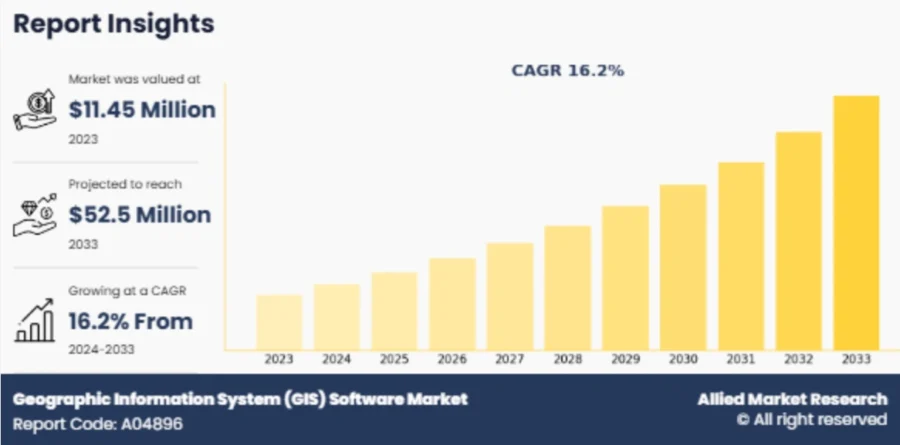
Credit: Allied Market Research
Advanced GIS tools also facilitate optimal land-use planning by analyzing spatial data. This leads to better decision-making for infrastructure development. Additionally, by integrating real-time traffic data with GIS, engineers strategically place transportation networks to alleviate congestion and enhance urban mobility.
Bunting Labs advances Automated Map Digitization
Bunting Labs is a US-based startup that modernizes map digitization using advanced AI techniques. The startup’s software, designed for GIS and engineering teams, automates the process of converting PDF utility maps into vectorized formats. Besides, the platform employs computer vision to georeference utility maps, regardless of their age, and extracts distinct utility layers.
Another feature involves pairing ground-penetrating radar (GPR) outputs with PDF utility maps to better identify underground lines. In this way, Bunting Labs’ approach to map digitization serves as a faster alternative to traditional time-consuming methods.
ai mapit enables Smart Asset Management
Irish startup ai mapit digitizes asset management using AI, computer vision, and GIS to rapidly create digital twins using available imagery. The platform features trained convolutional neural networks to detect objects in imagery, assigning accurate GPS tags to each identified asset. Post-processing tracks attributes like height, width, and condition over time, such as occlusion, growth, and damage.
This solution provides civil engineers with up-to-date geospatial records to streamline infrastructure management and reduce manual tracking and site visits. The startup’s approach ensures efficient management of distributed assets, promoting smarter asset management and reducing carbon footprints within construction projects.

6. Modular Construction & Prefabrication
Prolonged construction timelines, inconsistent quality control on-site, and the environmental impact of traditional building methods are some major issues that construction projects face. Modular construction and prefabrication enable engineers to design and assemble building components in controlled factory settings.
This way, project managers ensure consistent quality and reduce material wastage. Such prefabricated modules are then transported to construction sites, significantly slashing on-site construction time and minimizing environmental disturbances. Additionally, engineers optimize the design and assembly of these modules to deliver resilient and aesthetically pleasing structures.
Moreover, the market was valued at USD 155.3 billion in 2023 and is expected to register a CAGR of 5.7% from 2024 to 2032 due to rising demand for affordable housing and increasing global investments in healthcare and commercial infrastructure development.
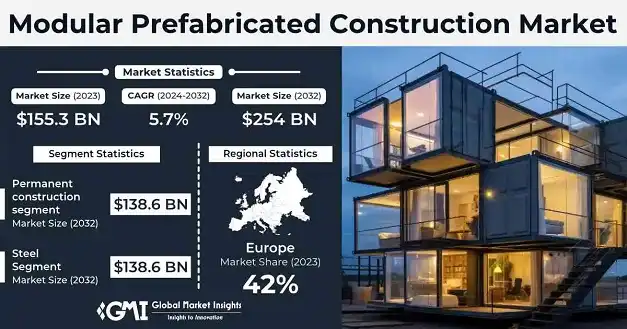
Credit: Global Market Insights
Wild Modular provides Modular Housing
Wild Modular is an Australian startup that manufactures a standardized accommodation pod, PRIMEPOD, to address worker accommodation shortages. The molecular pods feature structural steel with paint protection and a construction time of less than 12 days with a production capacity of 18 concurrent modules.
The engineering of the pods focuses on safety and durability with structural elements and insulation engineered for robustness and energy efficiency. This construction approach expedites the building process and also reduces waste, aligning with the civil engineering industry’s sustainable development goals and lowering construction costs.
Zen Modular enables Hybrid Modular Construction
French startup Zen Modular specializes in hybrid modular construction that comprises both on-site and off-site construction, combining permanent structural systems with removable living systems. Its platform allows architects and project owners to collaborate on modular construction projects. The platform also includes the provision to personalize standard modules according to project needs.
Besides, the startup’s platform provides real-time information on project cost, duration, and carbon impact estimation. Zen Modular’s hybrid construction optimizes construction processes, enhances collaboration with stakeholders, and promotes sustainability.
7. Structural Monitoring and Assessment
Civil engineers are challenged by the aging infrastructure, undetected structural flaws, and infrastructure corrosion. Innovations in structural monitoring and assessment are providing solutions to these concerns. For instance, advanced sensor technologies, such as fiber-optic sensors, are embedded within structures to collect real-time data on stress, strain, and potential deformations. This data is relayed to engineers to ensure timely interventions.
Further, the integration of machine learning algorithms allows civil engineers to predict potential structural failures based on historical and real-time data. Drones equipped with high-resolution cameras and infrared imaging also perform aerial inspections to identify issues undetectable through manual checks.
The global structural health monitoring market was valued at USD 4223.7 million in 2024. It is projected to grow from USD 4844.6 million in 2025 to USD 14513.3 million by 2033, with a CAGR of 14.7% during the forecast period.
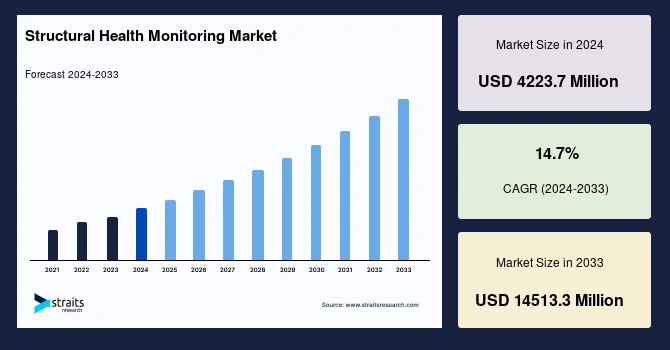
Credit: Straits Research
SURVIOT aids in Structural Movement and Deformation Monitoring
SURVIOT is a Hungarian startup that specializes in advanced structural health monitoring to improve movement and deformation tracking. The startup’s modular engineering platform integrates data acquisition from various sensors, including its proprietary monitoring PODs, and processes through a flexible, vendor-independent backend system.
The platform also leverages machine learning to offer valuable insights about the current state of projects. This allows civil engineers to interact with the platform via a web interface as well as visualize data through 3D maps, graphs, and tables. Additionally, the platform’s alert and reporting system provides periodic, customizable reports by converting raw data into easily interpretable charts.
StructuRight simplifies Structural Integrity Evaluations
US-based startup StructuRight provides advanced structural health and wellness monitoring solutions for various structures. Its BlackBox iS1 system offers real-time remote sensing with customizable sensor configurations and compatibility with solar power and low-voltage setups.
The startup employs a range of sensors, including distance, angle, and vibration sensors, to capture minute changes in structures to provide timely updates on structural health. Moreover, BlackBox iS1 detects anomalies and visualizes structural movement over time, enhancing decision-making.
8. 3D Printing
Traditional construction methods require a surplus in the purchase of materials, increasing wastage by the end of construction. Moreover, the industry struggles with the high costs of bespoke construction components, time-consuming mold creation for unique designs, and limitations in material versatility for specific applications.
3D printing allows engineers to use large-scale 3D printers to fabricate complex structural elements directly from digital models while eliminating the need for traditional molds and accelerating production time.
These large-scale 3D printers also allow for the use of a diverse range of materials, from concrete to polymers, tailored to specific structural requirements. The layer-by-layer printing approach facilitates the integration of utilities and reinforcements within components, streamlining the assembly process.
Further, the global 3D printing construction market was valued at USD 53.9 million in 2024 and is projected to grow at a CAGR of 111.3% from 2025 to 2030.
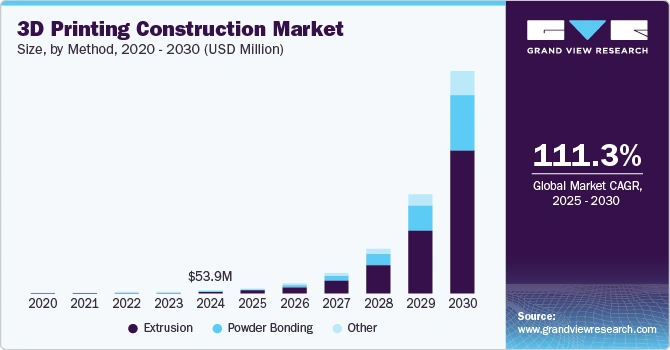
Credit: Grand View Research
minimass offers 3D-Printed Concrete Beams
minimass is a UK-based startup that creates low-carbon, low-cost, 3D-printed concrete beams. Its solution is a concrete and steel truss that creates stiffness and strength through axial compression and tension instead of typical bending and shear. Additionally, its manufacturing method significantly reduces the amount of concrete in comparison to conventional beams.
The startup’s patented technique prints concrete to eliminate the need for complex and costly formwork. By placing concrete precisely, it achieves substantial reductions in embodied carbon, material costs, and truck deliveries.
Layer Construction provides Autonomous 3D Printing Robots
US-based startup Layer Construction advances the construction sector through AI-powered 3D printing robotics. The startup offers a robotic solution for 3D and 4D printed construction that integrates both software and hardware. The AI-supervised software optimizes concrete printing to minimize errors, maximize material use, and continuously monitor various performance indicators.
The hardware facilitates continuous printing, interfacing seamlessly with concrete supply sources and operating around the clock. This approach accelerates project timelines and creates structures with extended longevity, significant cost savings, reduced environmental impact, and enhanced safety.
9. Advanced Materials
The advanced building materials industry is projected to grow from USD 284.86 billion in 2023 to USD 400.0 billion by 2032. The market’s CAGR is expected to be around 3.84% during the forecast period (2024–2032).
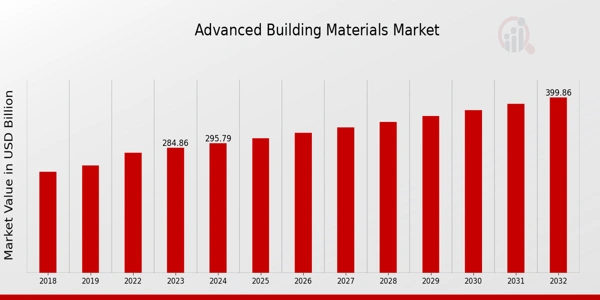
Credit: Market Research Future
Civil engineering projects are often challenging due to the vulnerability of traditional materials to environmental degradation and the weight constraints of certain construction elements. To overcome these limitations, startups are developing advanced materials, such as self-healing concretes, that autonomously repair cracks, extending the lifespan of structures.
Additionally, lightweight, high-strength composites are replacing conventional materials, allowing for more ambitious architectural designs without compromising structural integrity. The development of phase-changing materials that regulate temperature within buildings to reduce energy consumption is also a major development.
Mimicrete makes Biomimetic Self-Healing Concrete
Mimicrete is a UK-based startup that specializes in biomimetic self-healing concrete technologies. The startup’s self-healing concrete solutions actively mend cracks to prevent further structural issues and reduce repair needs.
By utilizing a vascular network containing a healing agent, Mimicrete’s system strengthens concrete, extending its lifespan without manual intervention. This solution reduces maintenance and also lessens the environmental impact by reducing concrete usage.
Ultra High Materials produces Geopolymer Concrete
US-based startup Ultra High Materials develops geopolymer and non-geopolymer concrete formulations by mixing a binder and aggregate with an activator solution at room temperature. The composite binder incorporates materials like blast furnace slag, fly ash, fumed silica, and metakaolin to create high-performance products. These products feature extremely high compressive strengths and exhibit superior corrosion and heat resistance.
Besides, Ultra High Material’s lightweight concrete products, both cellular and non-cellular, offer varied densities and strengths, with high thermal conductivity properties. These geopolymer concretes cater to diverse applications in the civil engineering sector and emphasize sustainability and high performance.
10. Disaster Management
Civil engineers are facing increasing challenges from the vulnerability of infrastructure to natural calamities and the inadequacy of early warning systems. Disaster management solutions in civil engineering prevent these issues through earthquake-resistant designs and retrofitting techniques that bolster structures against seismic activities.
Advanced satellite and sensor networks also provide real-time data on impending disasters like hurricanes or floods, enabling timely evacuations and preparations.
Further, the use of advanced algorithms in analyzing vast datasets allows civil engineering companies to predict disaster patterns and potential impact zones with greater accuracy. After the disaster, drones equipped with thermal imaging are deployed to assess damage and locate survivors, expediting rescue operations.
dataArrows offers Cloud-based Digital Twins for Buildings
US-based startup dataArrows provides TwinUp, its cloud-based software that features AI and the Internet of Things (IoT) to optimize building operations. The software creates real-time digital twins of structures using a 3D BIM environment with technology-agnostic edge devices that assist in collecting sensor data and managing building systems.
The platform visualizes facility details in an interactive 3D setting and uses AI to analyze and control building systems. Moreover, the platform allows civil engineers and designers to manage disasters, reducing response times and minimizing damage.
Aren delivers AI-powered Asset Intelligence
US-based startup Aren enhances the inspection of civil infrastructure using AI. The startup aggregates raw data from various sources, including drones, laser scanners, sensors, and photos, to create a high-resolution 3D digital twin of assets. This digital representation captures intricate details, providing a comprehensive view of the infrastructure.
Aren’s patented AI technology detects and quantifies damage, tracks its evolution, and predicts future structural changes. This predictive intelligence aids in optimizing repair, maintenance schedules, and spending. The technology serves both engineering firms and asset owners by offering risk mitigation, virtual site visits, and data-driven capital allocation plans.
Discover all Civil Engineering Industry Trends, Technologies & Startups
The use of hydrogel in construction offers the ability to absorb and retain large amounts of water, which is beneficial in arid regions for passive cooling. Additionally, kinetic pavements turn footsteps into a source of renewable energy, illuminating pathways and powering nearby infrastructures. Swarm robotic systems also perform tasks like site surveys and minor repairs to increase efficiency and reduce human intervention in hazardous areas.
These current trends in civil engineering outlined in this report only scratch the surface of trends that we identified during our data-driven innovation & startup scouting process. Identifying new opportunities & emerging technologies to implement into your business goes a long way in gaining a competitive advantage.






![AI in Construction: A Strategic Guide for Industry Leaders [2025-2030]](https://www.startus-insights.com/wp-content/uploads/2025/04/AI-in-Construction-SharedImg-StartUs-Insights-noresize-420x236.webp)
